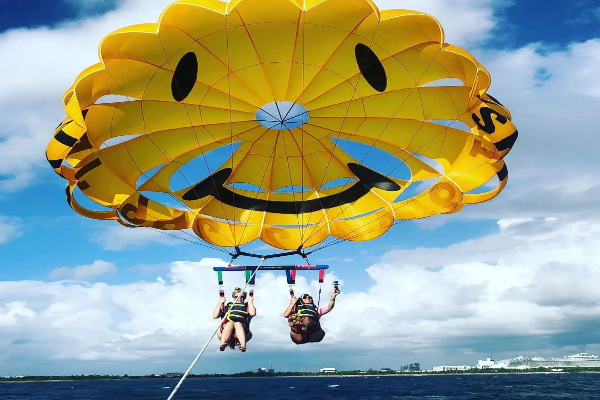Parasailing is an exhilarating water sport that combines the thrill of flying with the beauty of the ocean. It’s a popular activity for beachgoers and adventure seekers alike. This comprehensive guide will take you through everything you need to know about parasailing, from the basics to advanced tips, ensuring a safe and enjoyable experience.
Understanding Parasailing
What is Parasailing?
Parasailing involves being towed behind a boat while attached to a specially designed canopy wing that resembles a parachute. The boat moves, lifting the parasailer into the air.
History of Parasailing
The sport originated in the early 1960s when Pierre-Marcel Lemoigne, a French engineer, developed the first ascending-gliding parachute. The activity quickly gained popularity, evolving into the modern parasailing experience.
Preparing for Parasailing
Physical Requirements
Parasailing doesn’t require significant physical strength, but basic fitness is beneficial. Ensure you are in good health and free from serious medical conditions.
Choosing the Right Location
Look for a reputable parasailing operator. Coastal areas with calm waters and moderate winds are ideal.
Understanding Weather Conditions
Weather plays a crucial role in parasailing. Avoid parasailing in adverse weather conditions such as strong winds, rain, or thunderstorms.
Safety Equipment
Ensure the use of proper safety equipment:
- Harness: A comfortable and secure fit is essential.
- Life Jacket: Always wear a life jacket to ensure buoyancy in case of a fall.
- Helmet: Optional but recommended for added safety.
The Parasailing Process
Getting Started
Briefing Session
Operators provide a safety briefing before the activity. Pay attention to instructions regarding takeoff, flight, and landing procedures.
Equipment Check
Ensure all equipment is in good condition. Double-check harnesses, tow lines, and canopies.
Boarding the Boat
Board the boat calmly and follow the crew’s instructions. Sit comfortably and prepare for takeoff.
See Also: What Is Discover Scuba Diving
Takeoff
Positioning
Sit with your legs straight and slightly apart. Hold the harness handles firmly.
Lift-Off
The boat accelerates, and the canopy fills with air, lifting you gradually. Relax and enjoy the ascent.
In the Air
Maintaining Balance
Keep a steady posture and avoid sudden movements. The harness will support you.
Enjoying the View
Once stable, enjoy the breathtaking views. Look for marine life, coastal landscapes, and horizon vistas.
Landing
Preparing for Descent
The boat crew will signal the descent. Keep your legs straight and prepare for landing.
Touchdown
Land softly on the boat or water, as instructed. Follow the crew’s guidance to unhook safely.
Safety Measures
Following Instructions
Always follow the operator’s instructions. Safety briefings and guidelines are crucial.
Equipment Maintenance
Regularly check and maintain parasailing equipment. Replace worn-out gear promptly.
Avoiding Hazards
Be aware of potential hazards such as other watercraft, swimmers, and obstacles.
Advanced Parasailing Techniques
Tandem Parasailing
Experience parasailing with a partner. It requires slightly different harnesses and coordination.
Tricks and Maneuvers
Advanced parasailers can perform gentle maneuvers. Practice with an experienced operator.
High Altitude Parasailing
For thrill-seekers, some operators offer higher altitude experiences. Ensure proper safety measures.
Environmental Considerations
Marine Life Awareness
Respect marine life. Avoid disturbing animals and birds.
Eco-Friendly Practices
Choose operators committed to sustainable practices. Minimize your environmental footprint.
Legal and Ethical Considerations
Licensing and Regulations
Ensure operators have proper licenses and adhere to local regulations.
Ethical Practices
Choose ethical operators who prioritize safety and environmental responsibility.
Frequently Asked Questions
Is Parasailing Safe?
Yes, when conducted with proper equipment and trained operators.
What Should I Wear?
Wear comfortable swimwear. Avoid loose clothing that can get tangled.
Can Children Parasail?
Yes, children can parasail if they meet the operator’s age and weight requirements.
What Happens if the Tow Line Breaks?
Modern canopies allow for a controlled descent. The life jacket provides buoyancy.
How High Will I Go?
Heights vary, typically between 500 and 800 feet, depending on operator policies.
Do I Need to Swim?
Swimming skills are not mandatory but are beneficial for added safety.
Conclusion
Parasailing offers a unique blend of adventure and tranquility. By following the guidelines and choosing reputable operators, you can ensure a memorable and safe experience. Whether you’re a first-timer or an experienced thrill-seeker, the freedom of soaring above the water is an unparalleled delight. Enjoy the ride, stay safe, and cherish the memories!

